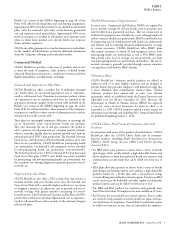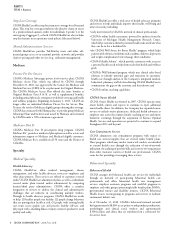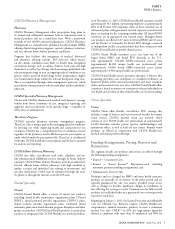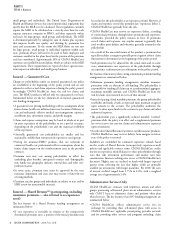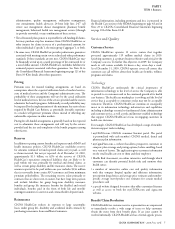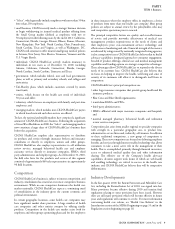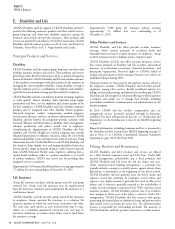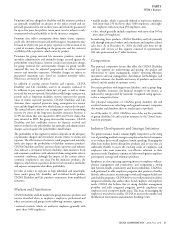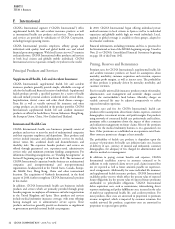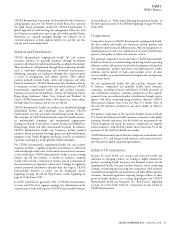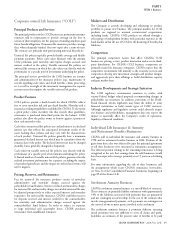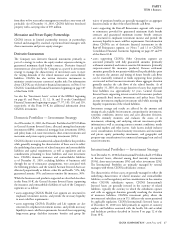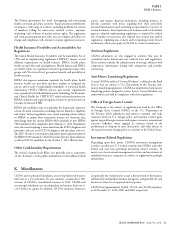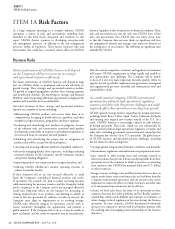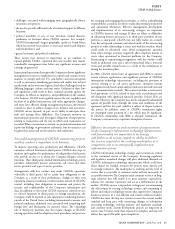Cigna 2010 Annual Report Download - page 33
Download and view the complete annual report
Please find page 33 of the 2010 Cigna annual report below. You can navigate through the pages in the report by either clicking on the pages listed below, or by using the keyword search tool below to find specific information within the annual report.CIGNA CORPORATION 2010 Form 10K 13
PARTI
ITEM 1 Business
CIGNA International’s operations are diversifi ed by line of business
and geographic spread of risk. However, South Korea does represent
the single largest geographic market for CIGNA International. A
global approach to underwriting risk management allows for each
local business to underwrite and accept risk within specifi ed limits.
Retentions are centrally managed through cost eff ective use of
external reinsurance to limit segment liability on a per life, per risk,
and per event (catastrophe) basis.
Markets and Distribution
CIGNA International’s supplemental health, life and accident
insurance products are generally marketed through distribution
partners with whom the individual insured has an affi nity relationship.
ese products are sold primarily through direct marketing channels,
such as outbound telemarketing and in-branch bancassurance.
Marketing campaigns are conducted through these channels under
a variety of arrangements with affi nity partners. ese affi nity
partners primarily include banks, credit card companies and other
fi nancial institutions. CIGNA International also distributes directly
to consumers via direct response television and the Internet. CIGNA
International’s supplemental health, life and accident insurance
businesses are located in South Korea, Taiwan, the European Union,
Hong Kong, Indonesia, China, New Zealand and ailand. In
China, CIGNA International owns a 50% interest in a joint venture
through which its products and services are off ered.
CIGNA International’s health care products are distributed through
independent brokers and consultants, select partners, CIGNA
International’s own sales personnel, telemarketing and the Internet. .
e customers of CIGNA International’s expatriate benefi ts business
are multinational companies and international organizations
headquartered in the United States, Canada, Europe, the Middle East,
Hong Kong, China and other international locations. In addition,
CIGNA International’s health care businesses include medical
products, which are provided through group and individual benefi ts
programs in the United Kingdom and Spain as well as to individual
expatriates and high net worth globally mobile individuals.
For CIGNA International’s supplemental health, life and accident
insurance products, a signifi cant portion of premiums are billed and
collected through credit cards. A substantial contraction in consumer
credit could impact CIGNA International’s ability to retain existing
policies and sell new policies. A decline in customer retention
would result in both a reduction of revenue and an acceleration of
the amortization of acquisition related costs. Changes in regulation
around permitted distribution channels may also impact CIGNA
International’s business or results. See the Regulation section
beginning on page 18 and the Risk Factors section beginning on
page 22 of this Form 10-K.
In 2010, South Korea generated 32% of CIGNA International’s
revenues and 49% of its segment earnings. For information on the
concentration of risk with respect to CIGNA International’s business
in South Korea, see “Other Items Aff ecting International Results” in
the International section of the MD&A beginning on page 54 of this
Form 10-K.
Competition
Competitive factors in CIGNA International’s supplemental health,
life and accident and health care businesses include product and
distribution innovation and diff erentiation, effi cient management of
marketing processes and costs, commission levels paid to distribution
partners, and quality of claims and customer services.
e principal competitive factors that aff ect CIGNA International’s
health care businesses are underwriting and pricing, relative operating
effi ciency, relative eff ectiveness in network development and medical
cost management, product innovation and diff erentiation, broker
relations, and the quality of claims and customer service. In most
overseas markets, perception of fi nancial strength is also an important
competitive factor.
For the supplemental health, life and accident insurance line
of business, competitors are primarily locally based insurance
companies, including insurance subsidiaries of banks primarily in
Asia and Europe. Insurance company competitors in this segment
primarily focus on traditional product distribution through captive
agents, with direct marketing being secondary channels. CIGNA
International estimates that it has less than 2% market share of
the total life insurance premiums in any given market in which it
operates.
e primary competitors of the expatriate benefi ts business include
U.S.-based and European health insurance companies with global
expatriate benefi ts operations. For the health care operations in the
United Kingdom and Spain, the primary competitors are regional
and local insurers, with CIGNA’s market share at less than 5% of the
premiums of the total local health care market.
CIGNA International expects that the competitive environment will
intensify as U.S. and Europe-based insurance and fi nancial services
providers pursue global expansion opportunities.
Industry Developments
Pressure on social health care systems and increased wealth and
education in emerging markets are leading to higher demand for
products providing health insurance and fi nancial security. In the
supplemental health, life and accident business, direct marketing
channels are growing and attracting new competitors while industry
consolidation among fi nancial institutions and other affi nity partners
continues. Increased regulations requiring foreign workers to show
proof of health insurance are creating opportunities for CIGNA
International’s health care businesses. See “Risk Factors” beginning
on page 22 of this Form 10-K for a discussion of risks related to
CIGNA International.


